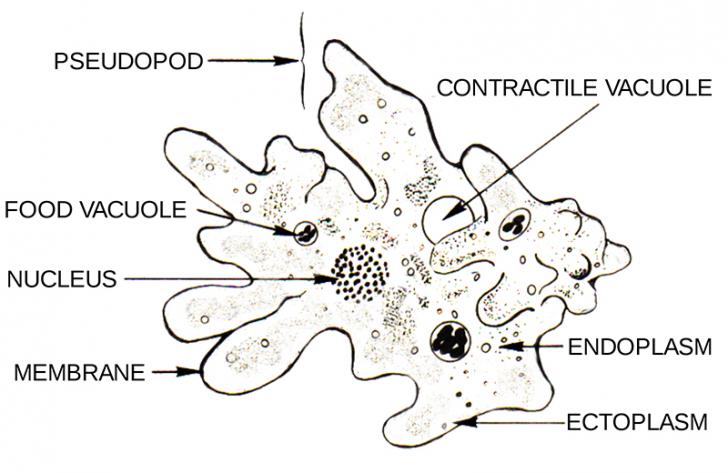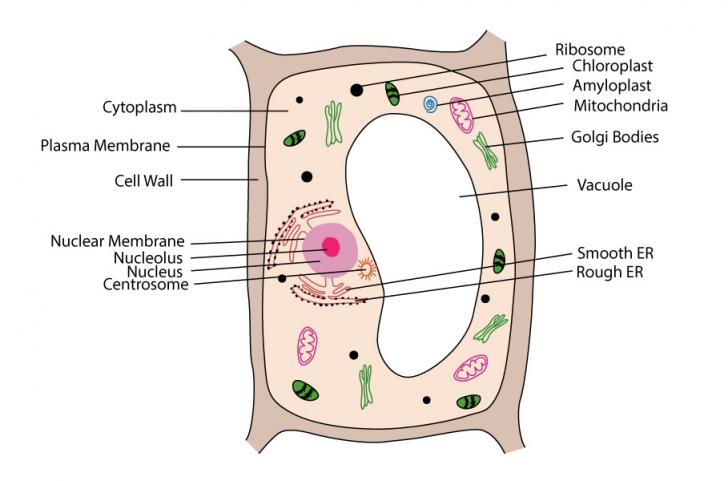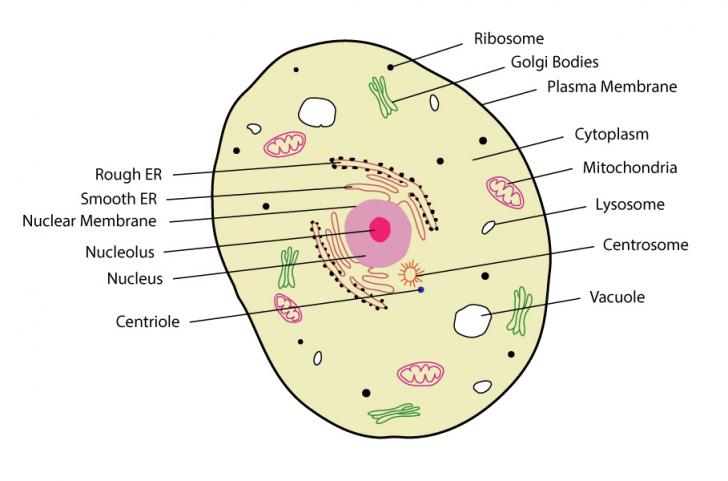Eukaryotic cell are the developed, advanced and complex forms of cells. They are the building block or smallest unit of life of organisms as simple as amoeba and protozoa to the most complicated plants and animals.
Significantly bigger than the prokaryotic cells, eukaryotic cells have diameter ranging from 10µm -100µm. Inside it are various cell organelles which performs individual functions and support cell life.
Structure
Eukaryotic cells have defined nucleus along with other membrane bound cell organelles such as mitochondria, ribosome, lysosome, Golgi bodies, endoplasmic reticulum, etc. All these cell organelles are held in their position by cytoplasm which is protected by plasma membrane. And the plasma membrane is further protected by the cell wall.
Unicellular Cell

There are several organisms made up of a single eukaryotic cell. For example, amoeba, protozoa, slime mold, and some forms of algae are single celled eukaryotes. Sperms, on the other hand, are singular cells found in animals (multicellular).
Eukaryotic unicellular cell consists of several organelles which carry out functions such as respiration, digestion, excretion, reproduction, locomotion, circulation and all others.
Cell membrane: It is the outermost covering of the cell which protects the cell from external environment.
Cytoplasm: The jelly-like substance that fills the cell is known as cytoplasm. In some organisms, it is divided into two types – ectoplasm and endoplasm.
Ectoplasm is the outer lining of cytoplasm, just below the cell membrane, which is much denser and clearer. It contains no organelles. It is thinner than the endoplasm.
Endoplasm is the cytoplasm that lies towards the center of the cell. It is granulated with various cell organelles embedded into it.
Pseudopodium: It is a temporary protrusion on the surface of amoeboid body. It helps in locomotion and in catching preys.
Cilia: Cilia are thin thread like structures which help the cell to swim or move in liquid.
Oral groove: It is an opening on the surface on the cell which leads to cell mouth and to the gullet. Foods that are swept into the oral groove are stored and digested inside the food vacuole.
Food vacuole: It is membrane-bound space in the cytoplasm with digestive enzymes which helps in degrading the food particles engulfed by the cell.
Contractile vacuole: It is a sub-cellular organelle which conducts osmoregulation; the process of removing excessive water along with waste products like ammonia and other salts from the cell in order to prevent the cell from bursting.
Anal pore: Residues are left once the nutrients from the food particles are absorbed into the cytoplasm. These residues are removed from the opening on the surface of the cell called anal pore. Some cells have two or more anal pores too.
Eukaryotic Plant Cell

Eukaryotic plant cell are developed and advanced form or cell which is similar to animal cell in several ways. However, these cells are bigger than the animal cells and have some added cell organelles.
Cell wall: It is the outermost layer which is present only in plant cell. It is slightly rigid and provides specific shape to the cell.
Plasma membrane: It lies below the cell wall and surrounds the entire cell. The thin layer acts as a protection layer.
Cytoplasm: It is the semi-fluid or jelly like structure which hold all cell organelles in place. It also prevents cells from being flaccid.
Ribosome: It is a complex molecule of RNA-protein which synthesizes protein in the cell.
Rough endoplasmic reticulum (ER): Endoplasmic reticulum which has ribosomes attached to its surface is known as rough ER. Its major function is to carry out the protein synthesizing process called translation.
Smooth endoplasmic reticulum (ER): Endoplasmic reticulum which lacks ribosome is called smooth endoplasmic reticulum. Basically, smooth ER’s function is to produce molecules according to the need of specific cell. In plant cell, smooth ER manufactures lipids or fatty acids.
Centrosome: It is round organelle present near to the nucleus. During mitosis, when the nuclear membrane breaks down, microtubules associated with centrosome interact with the chromosome and builds mitotic spindle.
Nuclear membrane: Nuclear membrane which is also called nucleolemma, nuclear envelope or karyotheca, is the covering membrane of nucleus. It is a bilayer of lipid which encases the genetic material.
Nucleus: Regarded as the brain of the cell, nucleus is the controlling unit. It controls every activity of the cell. Particularly, in plant cell, it is not located in the center; also it’s not towards the edge of the cell.
Nucleolus: It is the spherical body inside the nucleus. Its major function is to produce ribosomal subunits and to distribute them throughout the cell. These units combine together to form ribosomes which are responsible for producing protein.
Vacuole: It is an empty space or bubble found in the cytoplasm. It is much larger and is located more to the center in a eukaryotic plant cell. It helps in storing foods and other nutritional substances which support cell survival. It also stores waste products in order to prevent contamination of the entire cell. Usually, a single plant cell has single vacuole.
Mitochondria: Often referred to as the powerhouse of the cell, mitochondria are the cell organelles where biochemical respiration occurs. They have double layer of which the inner layer is folded inwards creating layers called cristae.
Golgi bodies: Golgi bodies are the composite of vestibules and folded membranes. It carries out various functions such storing and absorbing lipids, protein, and certain enzymes. Specifically in plant cells, Golgi bodies play vital role in synthesizing polysaccharides such as pectin, microfibrils of a-cellulose, hemicellulose, along with various mucilaginous products essential to form cell wall.
Chloroplast: It is colored pigment found in all plant cells and in algae too, which photosynthesis (the process of food for plant in presence of water, carbon dioxide gas and sunlight).
Amyloplast: It is non-pigmented organelles found only in certain plant cells. It synthesizes starch granules from polymerization of glucose and stores them. It can also revert the process to form glucose from starch granules in cases when plant is in need of energy.
Eukaryotic Animal Cell

Slightly smaller than the plant cell, animal cells are also advanced form of cell containing various cell organelles of various purposes.
Plasma membrane: Unlike in plant cells, plasma membrane is the outermost covering in eukaryotic animal cells. These cells are capable of adopting various shapes while some phagocytic cells can even consume other cells as they lack cell wall.
Golgi bodies: Golgi bodies in animal cells have more functions to perform than in plant cells. Some functions of this organelle are –
- They absorb various compounds such as bismutose, protargol, etc.
- Removes water from products that are being synthesized while forming secretory granules.
- Produces various enzymes such as follicular fluid in granulosa cells of ovary, zymogen granules, etc.
- Helps in producing hormones, especially of cells in thyroid gland.
- Stores proteins and lipids.
- Produces milk protein droplets in mammary glands.
Lysosome: It is membrane bound organelle in the cell whose major function is to digest or degrade waste and other excessive particles in the cell. It also digests engulfed cells like bacteria and viruses. Many plant cells may lack lysosome as they have larger vacuole which substitutes the role of lysosome.
Centrosome: Its structure and function is similar to that of the centrosome of plant cells. The only difference is that the centrosome in animal cells contains centriole.
Centriole: Present in animal cells only, centrioles a circular body associated with the centrosome which is responsible for development of spindle fiber during the process of cell division. Spindle fiber helps in separation of chromosomes.
Smooth endoplasmic reticulum (ER): In animal cells, smooth ER plays major role in producing calcium ions. Smooth ER present in cells of endocrine system is also responsible for regulating hormones.
Cell organelles or inclusions such as cytoplasm, mitochondria, nuclear membrane, nucleus, nucleolus, rough ER, vacuole and ribosome have similar structure and functions like those present in the eukaryotic plant cells. However, the vacuole is much smaller than it is in plant cells and may be present in multiple numbers. Also, the nucleus is centrally located.